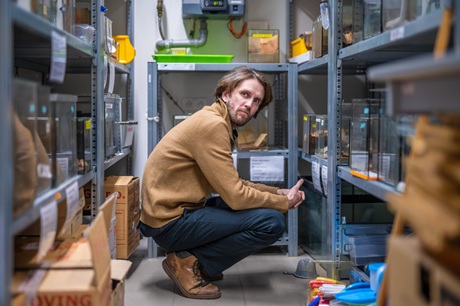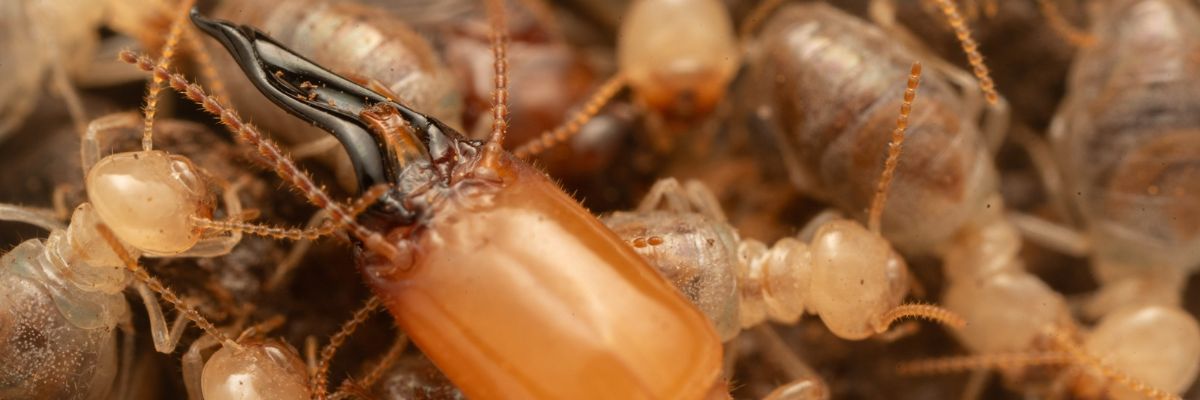
The secret of termites: Long-lived social insects that live in advanced colonies
21. 11. 2025
Not all bugs live fleeting lives. Royal termite pairs can survive for several decades, setting records for longevity in evolutionary terms as well – their advanced colonies have been around since the dinosaur era. The longevity of termite kings and queens is one of the topics studied by Robert Hanus’s research team at the Institute of Organic Chemistry and Biochemistry of the Czech Academy of Sciences. They’ve been maintaining laboratory termite colonies in the basement of their headquarters in Prague–Dejvice for several decades. What have they managed to find out about termites’ “elixir of youth”? How are bees, ants, and termites similar to each other, and what differentiates these representatives of social insects? The article is featured in the 2025 English issue of A / Magazine.
God save the Queen! And long may she reign! was a proclamation you might have heard British monarchists utter on occasion to honor Queen Elizabeth II up until 2022. It seems their wishes were granted, as the sovereign reached the age of 96, while her predecessor (and mother), Queen Elizabeth The Queen Mother, passed away at 101 years and 238 days.
Thanks to improved living conditions and advanced medicine, more people than ever – royal or not – are reaching the centenarian milestone. However, there are worlds where venerable age is the privilege of kings and queens alone – specifically, the hidden realms of termite mounds. It is estimated that in certain species, the royal pair, that is, the primary reproductive unit of the termite community, can live up to two (and possibly more) decades – an extraordinary lifespan for insects!
THE CZECH TERMITE SCHOOL
The longevity of termite kings and queens is one of the topics studied by scientists at the Institute of Organic Chemistry and Biochemistry of the Czech Academy of Sciences (IOCB Prague). They have unique conditions for this research, since they’ve been maintaining laboratory termite colonies in the basement of their headquarters in Prague–Dejvice for several decades.
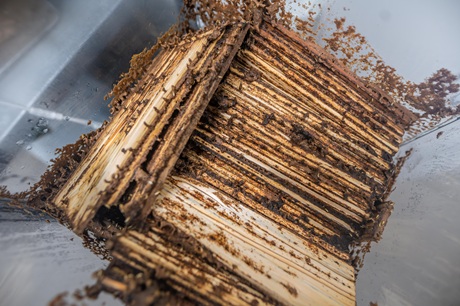
The termite colony in the basement of IOCB Prague feeds on spruce wood and numbers in the tens of thousands.
In the early 1960s, the first specimens of this tropical bug were brought to Czechoslovakia by researcher Ivan Hrdý, remembered by entomologists and organic chemists as the founder of the “Czech termite school.” He collected these insects primarily in China, Vietnam, and Cuba – places that were accessible to politically-allied countries during the Communist era.
As surprising as the combination of chemistry and bugs may initially seem, it makes sense. In the latter half of the twentieth century, there was significant societal demand for insecticides to combat pests harming increasingly more intensive agricultural production – some might recall the campaign against the Colorado potato beetle, or the “Yankee beetle”, presented as such in Cold War discourse.
At that time, there was a trend of developing synthetic insect hormones and researching pheromones – natural chemical substances used by the individuals of a species to communicate. Scientists believed that uncovering the chemical nature of these substances could lead to advancing methods for repelling bugs.
This led to a number of extremely interesting scientific projects launched in Prague, initially with significant application potential, which gradually also provided fundamental insights into basic research on insect communication.
A TREASURE IN THE BASEMENT
For nearly twenty-five years, Robert Hanus has been active in the termite lab at IOCB Prague, currently leading the Chemistry of Social Insects research group. He began working on this topic while studying at the Faculty of Science, Charles University in the early 2000s, and it was then that the story of a few particularly long-lived termite kings and queens began.

Robert Hanus from the Institute of Organic Chemistry and Biochemistry of the CAS. (CC)
“As a master’s student, I came to work one day and discovered that one of our colonies, originating from Cuba, was swarming. As a diligent caretaker, I sorted the winged kings and queens in pairs and placed them into glass containers, where they gradually formed new colonies that just kept growing and growing,” Hanus recalls.
The researcher continued to monitor the new colonies, observing the condition of the royal pairs; later, his students took over the observation of the termite palaces. This resulted in a continuous series of unique data on termite “families” and the longevity of their members.
“At the time of establishing the colonies, we could only dream of advanced techniques like genome sequencing. It was only many years later that I realized what a treasure trove we had at our disposal,” Hanus adds. Researchers combined the meticulously kept records of the termite nests and the ages of the kings and queens with modern genetic methods, opening up possibilities for remarkable discoveries.
LIFE IN COMMUNITIES
Entomologists and even lay observers, such as beekeepers, have long noted the longevity and fertility enjoyed by honey bee queens. Today, we know that even greater record-holders – both kings and queens – are hidden within termite mounds.
So how are bees, ants, and termites similar to each other, and what differentiates these representatives of social insects? They share a similar lifestyle in colonies – large family units. Individual members of a nest cooperate in its construction and maintenance, feeding and caring for the offspring, and defending the community. Together, they form a superorganism that operates according to clearly defined rules that have been in place for tens to hundreds of millions of years.
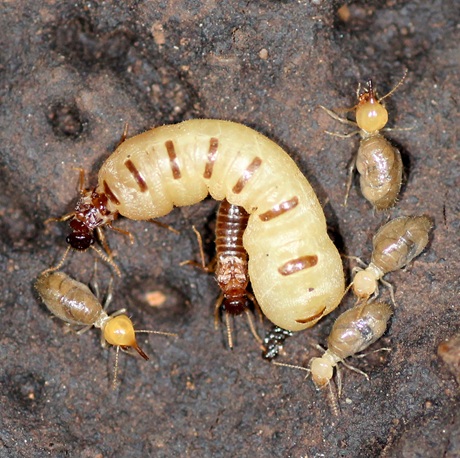
A termite mound can house up to millions of inhabitants: alongside the royal pair (center) live soldiers (with elongated heads) and workers.
Remarkably, this similarly structured social behavior evolved independently. While bees and ants belong to the order Hymenoptera and are relatively closely related, termites are quite distant from both. It’s somewhat ironic, since many people conflate termites with ants (termites were once called “white ants”). In reality, termites and ants are separated by tens of millions of years of independent evolution. Not only are they not “one family” – they are actually arch-enemies. Termites feed on decomposing wood and soil matter, while ants are predators that threaten termites.
The closest living “cousins” of termites are cockroaches. The separate lineage of termites diverged from their cockroach relatives approximately 150 million years ago. The oldest termite fossil dates back about 130 million years, making termites the most ancient representative of social insects. To date, researchers have described roughly three thousand species of termites inhabiting all continents except Antarctica.
The differences between termites and social hymenopterans include the distinct role of gender. Termite individuals maintain two sets of chromosomes, like vertebrates, so what we find in a termite colony are both male and female workers, soldiers, as well as a king and queen. With bees and ants, it works differently. Most inhabitants of beehives and anthills are females. The role of males is essentially limited to fertilizing the queen. Once they’ve fulfilled this duty, they die.
MEET THE QUEEN
The longevity of ant and bee males is not even a topic of discussion. That is why research studies on this subject focus exclusively on queens. Only in regard to termites does the terminology also include kings.
Each termite colony typically has only one primary reproductive pair (though some species function slightly differently). “The king stays with the queen for life and fertilizes her on a regular basis. This results in essentially one massive family: a mother, a father, and sometimes millions of offspring,” Hanus explains.

Some termite mounds are the size of a tennis ball; others can grow as large as a gorilla.
The first eggs laid by the founding pair of a new termite colony hatch into minuscule larvae, initially entirely dependent on the care of their parents. In mature colonies, the older generations of siblings take over raising the young. As the larvae develop, they differentiate into workers and soldiers, each caste with a precisely defined role, knowing exactly what to do and when. The colony grows and begins to function as an egg-producing machine.
In extreme cases, the queen lays several thousand eggs daily. Over a twenty-year reign, then, she may produce around twenty million offspring. But such a lifestyle takes its toll, which soon becomes apparent in her appearance. Rather than an elegant, stately dame, a termite queen is best imagined as a bloated matron, vastly outsizing her partner. While the average termite – including “His Majesty the King” – measures just a few millimeters, the egg-producing queen can grow to the size of a human palm. She looks more like an overstuffed caterpillar than a nimble six-legged insect.
Agility, however, is not a skill the queen requires. She barely moves, permanently confined with her mate in the royal chamber, which she never leaves throughout her long life. Small openings allow worker termites to access the chamber to care for their rulers, while termite soldiers stand guard. The soldiers protect the royal pair while the workers groom and feed it and remove the eggs laid by the queen.
The bleak fate of the founding pair raises the question of whether longevity is truly a blessing or a curse. It also begs a deeper inquiry: who actually rules the colony? Is it really the king and queen? Or are they merely captives of their offspring, who exploit them to the fullest for egg production? “Evolution does not concern itself with such sentimental questions. It simply evaluates how successful its strategies are across time and space, and in regard to termites, this strategy has been undoubtedly effective,” Hanus notes. Termites rank among the most populous organisms in tropical and subtropical regions, where their colonies have flourished for tens of millions of years.
|
FUN FACTS ABOUT TERMITES In Czech, termites used to be called “všekazi” (literally “destroyers of all”) because of their ability to consume books, wooden beams, or entire houses – a threat that still causes alarm in many parts of the world. Termites were historically referred to in English as “white ants” – a name used by British colonists in tropical regions. Many people think of termites as the tropical cousins of ants, which is a major misconception. Termites and ants are separated by millions of years of independent evolution. To date, scientists have described around 3,000 termite species living in a wide range of habitats. While most termites live in the tropics near the equator, they can also be found in North America, around the Caspian Sea, the Balkans, and the Mediterranean. The oldest known termite fossil dates back 130 million years, making termites one of the most ancient social organisms on Earth. Lower termites build smaller nests and feed on dead wood, which they are able to digest thanks to symbiotic protozoa in their guts. The symbionts in higher termites are gut bacteria and fungi which the termites cultivate in their mounds. A key factor in the evolutionary success of termites is their ability to digest cellulose – the structural component of plant cell walls. Although it is one of the most abundant organic materials on Earth, higher organisms cannot process it without microbial help. |
THE ELIXIR OF YOUTH
Over this immense timespan, termites have evolved a host of mechanisms that together create a kind of “elixir of youth,” accounting for the extraordinary longevity of kings and queens. Scientific studies have explored, for instance, the role of enzymes that counteract oxidative stress or the function of hormones in regulating development, metabolism, and aging.
Hanus’s team approached the issue from a different angle, focusing on telomerase – an enzyme that functions as a biological repair mechanism for telomeres, the specialized structures at the ends of chromosomes in eukaryotic cells. Telomeres can be compared to the plastic tips on shoelaces, preventing the fraying of material. Just as these tips protect laces, telomeres secure chromosomes from damage during cell division.
When telomerase activity is low, cells age more rapidly, potentially leading to degenerative processes. Conversely, if telomerase is hyperactive, it can promote uncontrolled cell growth, contributing to cancer development – which is why understanding this enzyme is crucial in human biology.
Hanus found inspiration in the work of colleagues at the Biology Centre of the CAS, who had studied honey bee queens and discovered that their telomerase activity was significantly higher than that of worker bees and drones.
While telomerase function is researched extensively in vertebrates, including humans, insect studies have been rare. “To our surprise, the link between telomerase and longevity in insects was almost entirely unexplored. The reason is simple: the fruit fly, which is the most commonly used insect model, completely lacks this enzyme and maintains chromosome integrity through alternative mechanisms,” Hanus explains.
“We reached out to our colleagues from the Biology Centre, who had made the honey bee discovery, and began collaborating. The results were astonishing. Across all studied termite species, telomerase activity in kings and queens turned out to be significantly higher than in workers and soldiers,” the scientist continues.

“For a long time, the link between the enzyme telomerase and insect longevity remained virtually unexplored,” says Robert Hanus. (CC)
The researchers also found telomerase in the royal pair to be active in unexpected places – not just in reproductive organs, but also in tissues where its activity seemed unnecessary. “It was highly active in the nerve cord, an equivalent to the spinal cord and brain, even though those cells do not divide and therefore have no need to elongate their chromosomes,” Hanus adds.
Looking deeper into the cells, the scientists discovered that telomerase in termite kings and queens was active even outside the cell nucleus – and to a far greater extent than in short-lived workers and soldiers. Its extranuclear role may be linked to stress protection in mitochondria (the powerhouses of the cell) and possibly other functions, all of which contribute to cellular longevity.
LONG LIVE THE QUEEN!
Even for long-lived kings and queens, wear and tear eventually take its toll. Repair mechanisms weaken, and key biomolecules age. The effects are even visible to the naked eye. “An insect that lives for twenty years may have a missing leg or other signs of wear. In queens, aging can also be seen in the fat storage organ, which is bright white in youth, but turns yellow with time,” Hanus notes.
As the royal pair nears the end of its reign, the colony can sense the change, triggering a struggle for power. Some immature termites (nymphs) begin transforming into secondary reproductives (becoming neotenic). They develop reproductive organs, mate, and the new queens start laying eggs. In some species, neotenic queens coexist with the original queen, but in most cases, the latter prevents competition from arising through its presence. Controlling the number of secondary reproductives is not just in the queen’s interest – the workers and soldiers also prefer a stable colony, as caring for too many royals is a burden.
A healthy, actively reproducing queen releases a pheromone that signals to the rest of the colony that everything is under control and that they do not need to waste energy on reproduction. And when the queen is missing, infertile, or dying, the absence of this primer pheromone alerts her daughters to the opportunity to transform into successors.
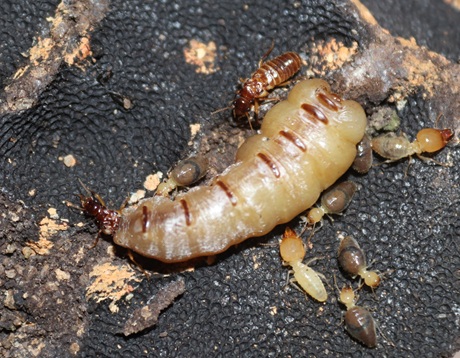
When young, the termite queen is white. As she ages, she gradually turns yellow.
“Termite queen primer pheromones play a crucial role in termite society, yet scientists were unable to chemically identify them until quite recently. While honey bee queen pheromones were discovered as early as the 1960s, those of ants, wasps, and bumblebees were identified much later – likewise with termites,” Hanus says.
The first identification of a termite queen pheromone was published about fifteen years ago by Japanese researchers studying a species of lower termites. Around the same time, Hanus and his students also began working on the topic.
THE ROYAL PERFUME
Termites are classified into lower termites (fewer than a third of the 3,000 known species) and higher termites, which make up the majority. It was Czech scientists who finally managed to decipher the chemical nature of the primer pheromone in higher termites. In 2022, they published a study in Communications Biology describing the substance secreted by the queen of the termite species Embiratermes neotenicus.
This species, which inhabits the tropical Amazon rainforest, has a unique system of replacement termite queens that functions somewhat differently from the one described earlier. In the early stages of the colony’s life cycle, the founding queen is already substituted by a group of dozens to hundreds of replacement queens. These queens arise from unfertilized eggs through parthenogenesis – meaning they are essentially clones of their mother.
The female nymphs then wait patiently for the right time to replace the queen – i.e., for her death. Once they transform into queens, they form something like a harem, in which a single king mates with dozens to hundreds of small queens. This process produces workers and soldiers, as well as winged kings and queens that leave the nest to establish new colonies. Meanwhile, the queens in the harem occasionally lay unfertilized eggs, which develop into new clonal queens that replenish the harem.
The regulation of the number of replacement queens and the signal indicating the need to produce them is mediated precisely by the queen primer pheromone. Scientists identified it as a sesquiterpene compound, specifically (3R,6E)-nerolidol. “It’s a fragrant terpene substance commonly found in perfumes. It’s clear that termite queens must have a distinctive scent for their subjects. Of course, as humans, we can’t detect it because it occurs in extremely low concentrations,” Hanus notes.
|
TERMITES WITH BLUE “BACKPACKS” |
The researchers managed to discover where and how the primer pheromone is produced. A single specialized enzyme is responsible for it, one that is highly active in the queen’s skin but entirely absent in other members of the termite colony. The scientists also tested the pheromone’s effects experimentally. They removed princesses (nymphs that have the potential to become replacement queens) from the colony and exposed them to the scent of the reigning queen’s perfume. Its presence sent a clear message: do not attempt to transform into a queen. Conversely, when the scent was removed, the nymphs began to develop into replacement queens.
Additional experiments showed that the royal perfume works even from a distance. The princesses could sense it even when separated by a metal grid, and they responded precisely as dictated by the queen’s chemical signal. One might be tempted to say termites have exceptionally sensitive noses – but in reality, their olfactory receptors are mainly located on their antennae.
FROM ANTENNAE TO EVOLUTION
In fact, antennae are an intriguing subject of study. The Prague-based scientists recently brought back a supply of termite antennae directly from the field in French Guiana. Although they have maintained viable colonies of multiple termite species in their Prague laboratory for decades, they need to travel to the tropics regularly to observe termites in their natural habitat and collect samples on-site for broader research insights.
Hanus most frequently – and most eagerly – returns to French Guiana. Not only does he speak fluent French, making it easy to communicate with locals, but the country is also an overseas region of France and thus part of the European Union. This means it operates under EU regulations, sparing researchers the bureaucratic hurdles they often face, for instance, in Africa.
The Czech researchers have established ties with the university campus in Kourou, which, incidentally, is also home to the spaceport from which European space missions are launched. “In Kourou, we have access to a small tropical field station where we’ve set up a lab with a microscope. Thanks to this local facility, we can prepare samples on-site just as we would in Prague. This is exactly how we prepped the antennae we are currently studying in our lab,” the scientist explains.
And those antennae can reveal quite a lot – such as identifying candidate receptors for specific pheromones. In addition to the royal perfume that regulates reproduction in the termite colony, there are also pheromones for alarm, foraging, construction, trail-marking, and more. Each of these pheromones can be linked to the enzymes responsible for their production, as well as to the receptors in the antennae that allow termites to perceive them.
|
A TERMITE MOUND FLATSHARE |
Each termite species has about fifty candidate receptor proteins. By tracing these proteins and their genes far back into evolutionary history, scientists can approximate when a particular protein and its corresponding gene first appeared. This, in turn, helps identify when specific types of communication evolved.
“This opens up an opportunity to look at evolution – at how and when termites, who once barely communicated, developed into eusocial insects that use a rich chemical language,” Hanus says, outlining the next direction of his research.
LOOKING AHEAD
At the same time, Hanus has other research aspirations. One of them is to decipher the chemical nature of the construction pheromone, which helps termites build their nests. Termites assemble these structures inch by inch, row by row, precisely determining when to add another layer, seal a chamber, or create a ceiling. Chemical signals allow them to recognize that a certain section has been standing for a while and that it’s time to shift construction in another direction. However, the chemical foundation of this signaling substance remains unknown.
Another unresolved topic is the remarkable longevity of termite kings and queens. The termite colonies in the Prague lab are still thriving. The oldest kings and queens are now twenty-three years old and in excellent health. Just last autumn, a student from the Prague team, Marie Pangrácová, successfully defended her doctoral thesis on this topic, and other research groups are continuing to investigate the termites’ “elixir of youth,” promising further fascinating discoveries.
A particularly intriguing question is what makes termites so evolutionarily successful. They have the ability to digest cellulose, aided by special gut bacteria and flagellates that they carefully cultivate. And Hanus’s team has uncovered another key adaptation: termites can produce linoleic acid, one of the essential fatty acids. “Unlike most other animals, termites are not dependent on dietary intake of these substances, which has allowed them to become experts at consuming dead wood – and in doing so, they have essentially taken over the tropics,” Hanus explains. Termites acquired this competitive advantage a very long time ago. The gene for the enzyme that enables them to synthesize linoleic acid was inherited from their ancestors approximately 160 million years ago.
Advances in genetic research now offer even deeper insights into insect evolution. In the case of termites, this means looking far back into the past. After all, they dominated terrestrial ecosystems long before the first bee and ant colonies appeared – and long before we humans arrived. Understanding the survival strategies of these insect Methuselahs is sure to be well worth the effort.
|
Mgr. Robert Hanus, Ph.D.
Robert Hanus studied zoology at the Faculty of Science while also pursuing sociology at the Faculty of Arts at Charles University in Prague. This unusual academic combination led him to an interest in termites as key representatives of social insects. He studies their chemical communication, unique caste systems, reproductive strategies, and the remarkable longevity of termite kings and queens. His research also focuses on the evolutionary adaptations that have made termites one of the most successful terrestrial animal groups. Since 2014, he has led the Chemistry of Social Insects research group at the Institute of Organic Chemistry and Biochemistry of the CAS. His most frequent trips to study termites have taken him to French Guiana, an overseas territory of France in South America. |
The English article on termites first came out in the 2025 issue of A / Magazine of the CAS as “Long Live the King and Queen! The Story of Immortal Termites.”
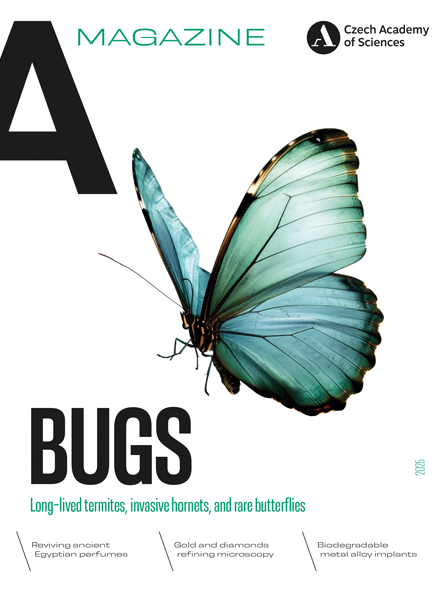
2025 (version for browsing)
2025 (version for download)
All Czech and English issues of A / Magazine – the official quarterly of the Czech Academy of Sciences, including its predecessor A / Science and Research – are available online.
We offer free print copies (of the Czech version and the two English issues from 2024 and 2025) to anyone interested – please contact us at predplatne@ssc.cas.cz.
Written and prepared by: Leona Matušková, External Relations Division, CAO of the CAS
Translated by: Tereza Novická, External Relations Division, CAO of the CAS
Photo: Shutterstock, Robert Hanus, Jana Plavec, Aleš Buček
 The text, photos marked CC, and photos of Robert Hanus in his bio are released for use under the Creative Commons license.
The text, photos marked CC, and photos of Robert Hanus in his bio are released for use under the Creative Commons license.
Read also
- Two ERC Synergy Grants awarded to the Czech Academy of Sciences
- Nine CAS researchers received the 2025 Praemium Academiae and Lumina Quaeruntur
- Step inside the world of research: Week of the Czech Academy of Sciences 2025
- A / Magazine: Bugs, the rusting human body, and beauties from the kingdom of ice
- PHOTO STORY: The invasive black bullhead catfish threatens Czech fishponds
- Rewrite the textbooks – we’ve found a bone; aka When science takes a wild turn
- CAS researchers receive L’Oréal-UNESCO Award and Forbes recognition
- Young scientists discussed economic challenges with Nobel laureates in Lindau
- A cure for cancer? Fighting the climate crisis? Ask the data scientists
- Vice-Presidents of the CAS set priorities for 2025–2029 term
The Czech Academy of Sciences (the CAS)
The mission of the CAS
The primary mission of the CAS is to conduct research in a broad spectrum of natural, technical and social sciences as well as humanities. This research aims to advance progress of scientific knowledge at the international level, considering, however, the specific needs of the Czech society and the national culture.
President of the CAS
Prof. Eva Zažímalová has started her second term of office in May 2021. She is a respected scientist, and a Professor of Plant Anatomy and Physiology.
She is also a part of GCSA of the EU.


